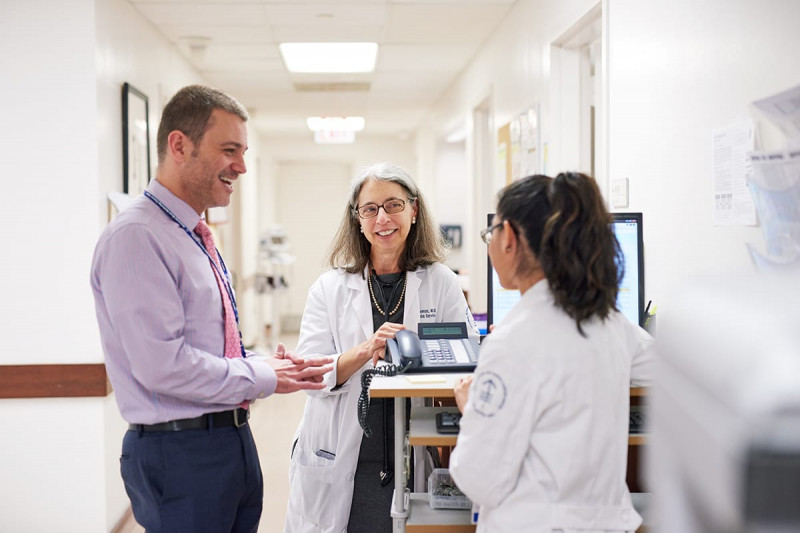
Larry Buie, Clinical Pharmacy Specialist (left) Ellin Berman, MD (center) and Sara De La Cruz, RN, are part of the leukemia team of specialists at MSK.
Doctors categorize leukemia based on which type of white blood cell is involved — lymphocytes or myeloid cells — and whether the illness is developing very quickly (acute disease) or slowly over time (chronic disease).
Lymphocytic leukemias develop from cells that give rise to T lymphocytes (T cells), B lymphocytes (B cells), or natural killer (NK) cells. Each of these cell types has a specialized role in the immune system; some produce antibodies, whereas others directly fight or direct other immune cells to fight infections.
This information is about leukemia in adults.
Myeloid leukemias develop from cells that give rise to white blood cells called granulocytes and monocytes. Granulocytes get their name from the enzyme-packed granules they carry inside them. They release these enzymes when encountering invading bacteria or fungi. Monocytes eventually become macrophages, which engulf and destroy bacteria and fungi.
In acute leukemias, which develop rapidly, the malignant cells (called blasts) are immature and incapable of performing their immune system functions. Chronic leukemias develop in more-mature cells, which can perform some of their duties — but not very well. These abnormal cells usually multiply at a slower rate than acute leukemias.
Of the four common types of leukemia in adults, acute myeloid leukemia (AML) and chronic lymphocytic leukemia (CLL) occur most frequently. Other related blood cancers include myeloproliferative neoplasms and systemic mastocytosis.
-
About Hairy Cell Leukemia (HCL)
Hairy cell leukemia (HCL) is a rare cancer in adults that is usually found during testing for a low blood count. Read more about what doctors at MSK are looking for when they diagnose HCL. -
Acute Lymphocytic Leukemia (ALL)
Acute lymphocytic leukemia (ALL) is a rare cancer in adults, but it is the most common form of leukemia in children. Read more about what doctors at MSK are looking for when they diagnose ALL. -
Acute Myeloid Leukemia (AML)
Acute myeloid leukemia (AML) is one of the most common leukemias in adults. Learn more about AML and how it’s diagnosed. -
Acute Promyelocytic Leukemia (APL)
Acute promyelocytic leukemia (APL) is an aggressive type of acute myeloid leukemia. Learn more about APL and how it’s diagnosed. -
Chronic Lymphocytic Leukemia (CLL)
Chronic lymphocytic leukemia (CLL) is the most common chronic leukemia in adults. Therapies for CLL are improving and changing rapidly. Learn about treatments for CLL. -
Chronic Myeloid Leukemia (CML)
Learn more about what role chromosomes play in developing chronic myeloid leukemia (CML). -
Myeloproliferative Neoplasms (MPN)
See what it is that bone marrow does and how it can lead to the development of disorders known as myeloproliferative neoplasms. -
Systemic Mastocytosis
Mastocytosis happens when too many mast cells build up in the body. Read about how this disorder is diagnosed and its relationship to allergies.


